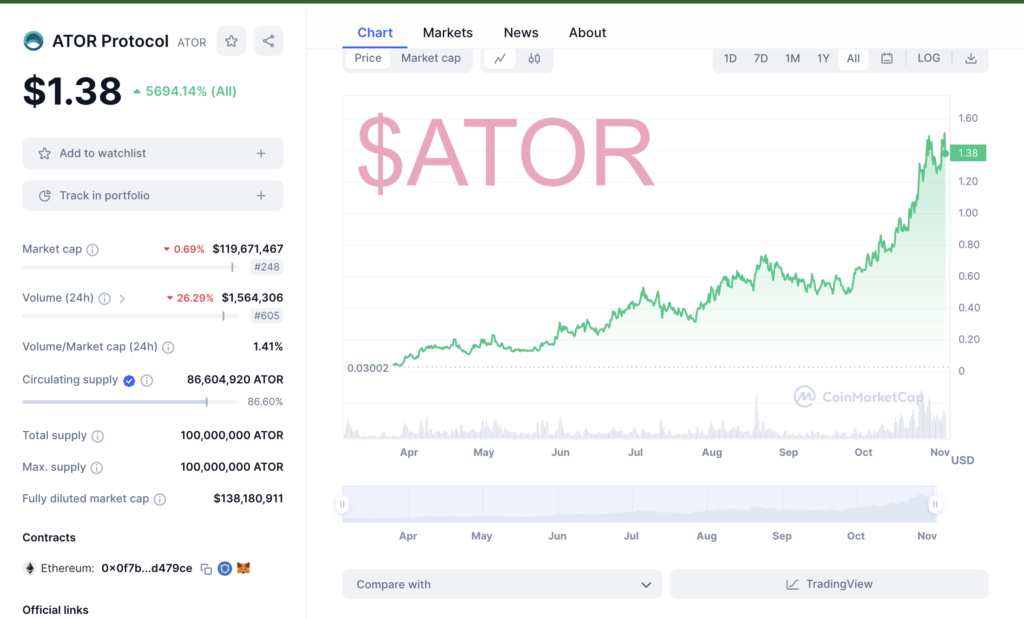The ATOR protocol is a pioneering privacy-focused crypto project that seeks to incentivize the expansion of the Tor Network’s relay nodes. Beyond enhancing Tor’s capabilities, ATOR exhibits intriguing features and tokenomics that set it apart from other projects. In this article, we will delve into the ATOR protocol, examining its unique features and its potential impact on the future of online privacy.
The Genesis of ATOR Protocol
ATOR, short for “A Tor,” is a privacy crypto project that recently released its white paper, outlining updated tokenomics and the project’s vision. Interestingly, the tokenomics for ATOR were not devised by the project’s founders. Instead, they collaborated with a financial data science company called Findos. Risto Pionkov, with over a decade of experience in analytics, data science, and machine learning, is the mastermind behind ATOR’s tokenomics.
The Vision of ATOR
The core objective of ATOR is to encourage the growth of the Tor Network by expanding the number of active relays. The Tor Network, known for its privacy-centric architecture, has recently faced challenges. The number of relays in the Tor Network has seen fluctuations, with recent dips raising questions. The ATOR protocol aims to address these challenges and bolster the network’s strength. Tor’s lower adoption compared to mainstream browsers can be attributed to its slower browsing speed, which hinders mass adoption.
ATOR’s Unique Hardware Solution
ATOR introduces a unique all-in-one hardware solution, combining a router and a Tor relay. This hardware is designed to offer a hassle-free, Plug and Play experience for users. Torifying an entire network is a groundbreaking concept, providing users with the ability to protect their online activities. Although the hardware’s potential impact is significant, its feasibility and potential drawbacks warrant further exploration.
Tokenomics and Token Supply

The $ATOR token has a fixed supply of 100 million tokens. As of November 2, 2023, 86.5% of the ATOR token supply is in circulation. The remaining tokens are allocated to different purposes, including rewards for Tor relays and funding development. A 4% tax on trading $ATOR tokens on the Uniswap platform has enabled them to be self-funded. The project also plans to reduce fees gradually, ultimately aiming for a zero-tax token.
Running a Tor Node with ATOR
To run a Tor node with ATOR, users can either purchase the dedicated hardware or set up a virtual machine relay. The hardware is estimated to cost between $250 and $300, and it offers a seamless setup process. Notably, users opting for the virtual machine relay will need to lock up 100 $ATOR tokens for 180 days to qualify for rewards. The release schedule for $ATOR tokens is structured to ensure fairness and sustainability. One of its key strengths is its potential to foster an ecosystem on top of the Tor Network. This ecosystem can host various services, including anonymized storage, file sharing, streaming, compute jobs, news and publishing, and peer-to-peer marketplaces. Developers can build applications that align with market demands and leverage the growing pool of Tor relays. This opens the door to a multitude of privacy-enhancing services.
The ATOR protocol is an exciting project that has the potential to revolutionize online privacy and the Tor Network. With its innovative hardware, unique tokenomics, and plans to build an ecosystem on top of the Tor Network, ATOR presents a fresh perspective on digital privacy. While challenges and uncertainties exist yet ATOR is a project to watch as it continues to evolve and potentially reshape the landscape of online anonymity and security.
You can read up more on the project on their website here.




Pingback: $CHNG : Revolutionizing Decentralized Finance | ourcryptotalk.com
Pingback: Render Token is a great Investment | 100X Potential | Cryptocurrency